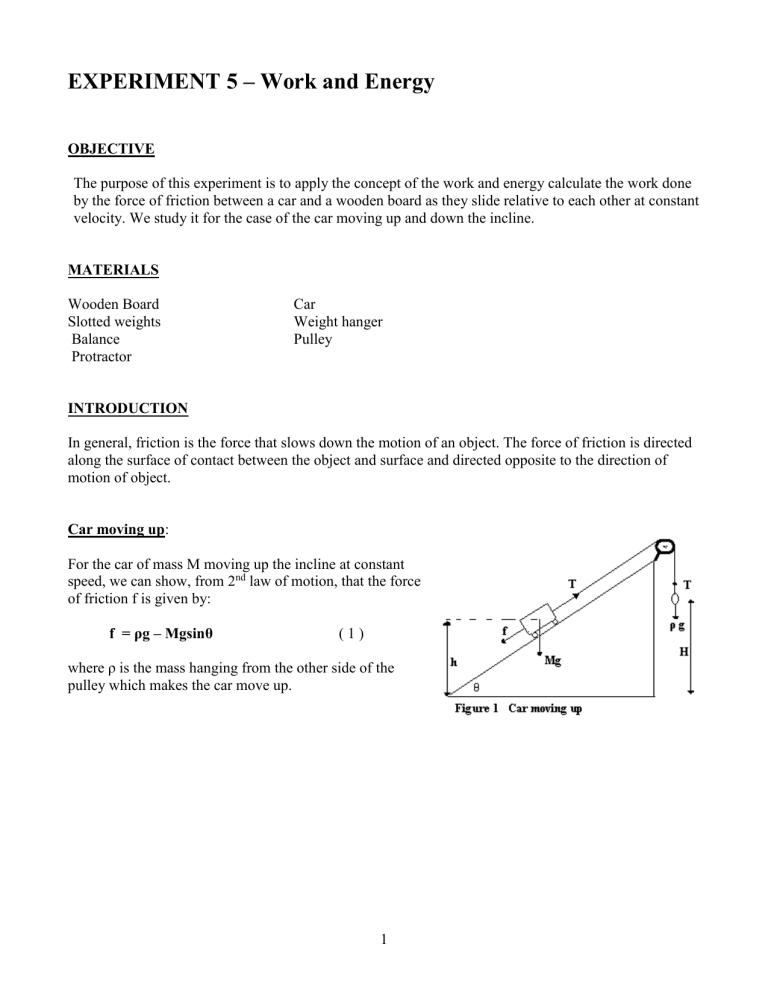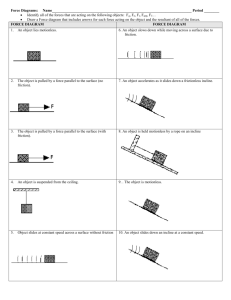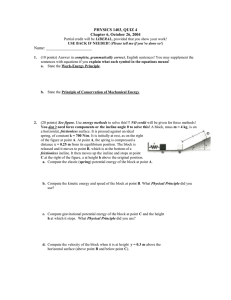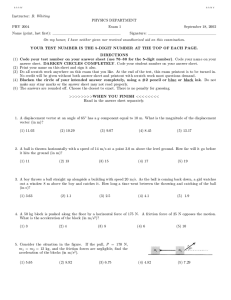06_Work and Energy.doc

EXPERIMENT 5 – Work and Energy
OBJECTIVE
The purpose of this experiment is to apply the concept of the work and energy calculate the work done by the force of friction between a car and a wooden board as they slide relative to each other at constant velocity. We study it for the case of the car moving up and down the incline.
MATERIALS
Wooden Board
Slotted weights
Balance
Protractor
INTRODUCTION
Car
Pulley
Weight hanger
In general, friction is the force that slows down the motion of an object. The force of friction is directed along the surface of contact between the object and surface and directed opposite to the direction of motion of object.
Car moving up :
For the car of mass M moving up the incline at constant speed, we can show, from 2 nd
law of motion, that the force of friction f is given by: f = ρg – Mgsinθ ( 1 ) where ρ is the mass hanging from the other side of the pulley which makes the car move up.
1
Car moving down :
Now, for the car of mass M moving down the incline at constant speed, we can show, from 2 nd
law of motion, that the force of friction f is given by: f = M g sinθ – ηg ( 2 ) where η is the mass hanging from the other side of the pulley which makes the car move down up.
And finally the work done by friction becomes:
W f
= f d ( 3 )
Where d is the distance the car travels along the board.
EXPERIMENTAL PROCEDURE
1) Determine the mass M of the car and record it..
2) Set up the board and the car as shown in figure 1 with an incline angle of 30 0 with the table.
Position the car near the bottom of the incline and record its initial height h. Add enough weights of mass ρ on the weight hanger to make the car move up the incline at a very slow speed after given a slight tap. Record the initial height H of this weight. Measure also the distance d that the car travels along the board.
3) When the car reaches near the top of the incline, record now its height h and that of the weight hanger H. Start removing weights from the weight hanger until the car starts moving down the incline at a slow speed after given a small tap. Record this mass η.
4) Repeat the above procedures for an incline angle of 60 0 .
2
EXPERIMENT 5 – Work and Energy
REPORT FORM
Name ______________________
Date _____________________
Part 1 Car moving up the incline
Mass M of car ____________
Angle of incline
30 0
Mass ρ d Initial height of car, h
60 0
Part 2 Car moving down the incline
Angle of incline
30 0
Mass η d Initial height of car, h
60 0
Percent difference in W f
for θ = 30 0 _________
Percent difference in W f
for θ = 60 0 _________
Initial height of suspended mass, H
f
Initial height of suspended mass, H
f
W f
W f
3
CALCULATION
1) Compute the frictional force f and the work W f
done by friction for the incline angle of 30 0 .
2) Compute the frictional force f and the work W f
done by friction for the incline angle of 60 0 .
3) For each angle, compute the percent difference in the two values of the work W f
.
4
EXPERIMENT 5 – Work and Energy
Review Questions and Exercises
Due before lab begins. Answer in the space provided.
Name _____________________
Date ___________________
1) Write down the conservation of the mechanical energy of a system?
Is it always conserved? Explain.
2) Shoe the steps leading to equations ( 1 ) and ( 2 ).
3) What are the main assumptions about the pulley in this experiment?
4) How does the force of friction in this experiment depend upon the angle of the incline?
5) Explain why the total energy of a system can be either positive or negative, whereas the kinetic energy is always positive.
5
EXPERIMENT 5 – Work and Energy
Post- laboratory Questions and Exercises
Due after completing lab. Answer in the space provided.
Name __________________
Date _____________________
1) Compute the percent energy lost to friction for the car moving up the incline for both angles.
2)
For θ = 60
0 , compute the work done by each force acting on the car. Should they add up to zero?
Explain.
3) For θ = 30
0 , compute the normal force acting on each wheel of the car?
4) Is friction in this experiment only due to the car? Explain.
5) For the car moving up the incline, show the steps leading to the below equation:
6



